Microeconomic Analysis: Elasticity of Demand and Types
VerifiedAdded on 2022/08/24
|6
|1220
|24
Homework Assignment
AI Summary
This assignment provides a comprehensive overview of the concept of elasticity of demand in microeconomics. It begins by defining demand elasticity and explaining how it measures consumer responsiveness to price changes and other factors. The assignment then delves into the different types of demand elasticity, including price elasticity of demand, cross-price elasticity of demand, and income elasticity of demand. Each type is explained with formulas, examples, and real-world scenarios. The assignment covers how to calculate elasticity, interpret the results, and understand the implications for businesses and consumers. The discussion includes how these elasticities are used to forecast demand, analyze market behavior, and make informed decisions. The assignment also highlights the relationship between different goods, such as substitutes and complements, and how their prices affect each other.
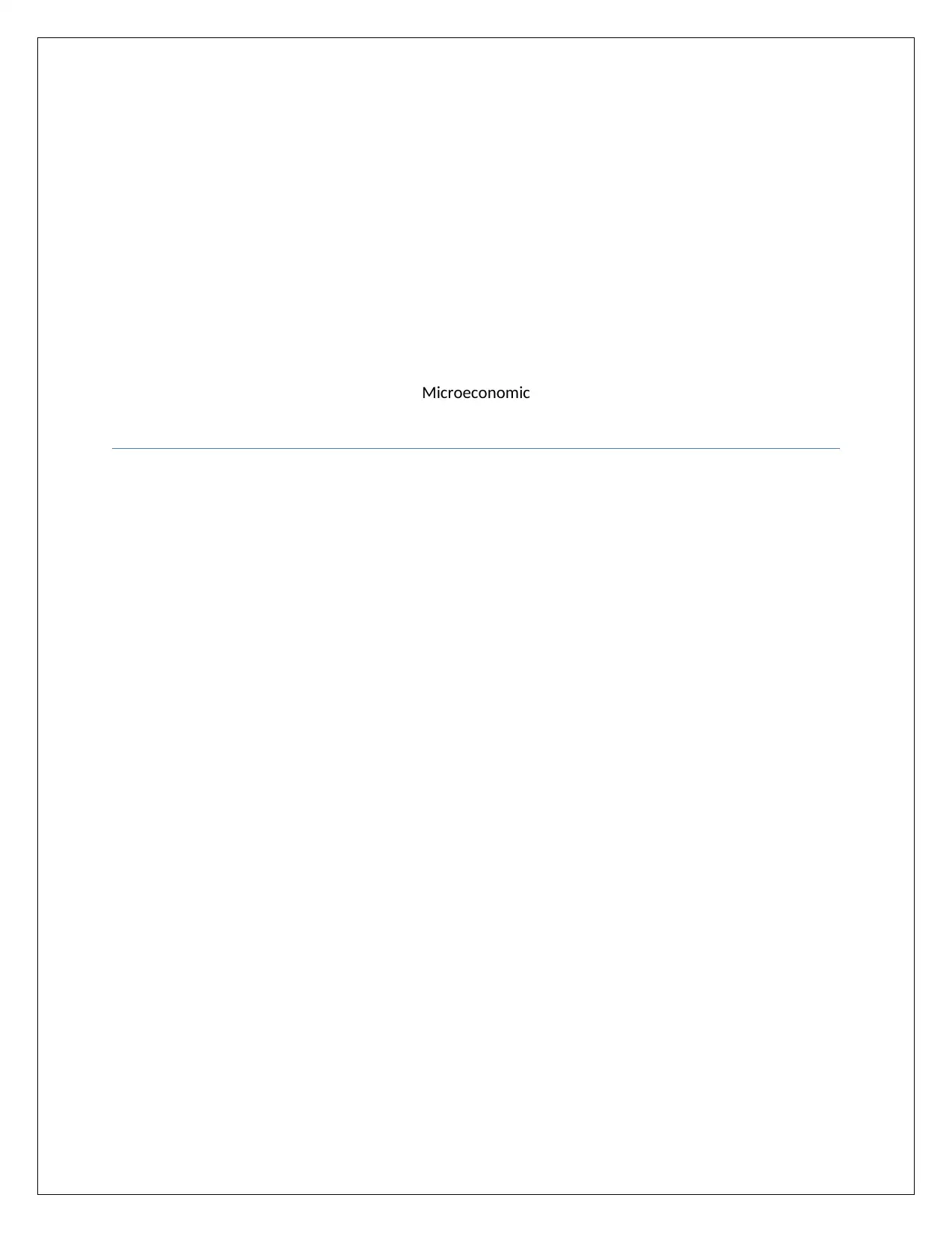
Microeconomic
Paraphrase This Document
Need a fresh take? Get an instant paraphrase of this document with our AI Paraphraser
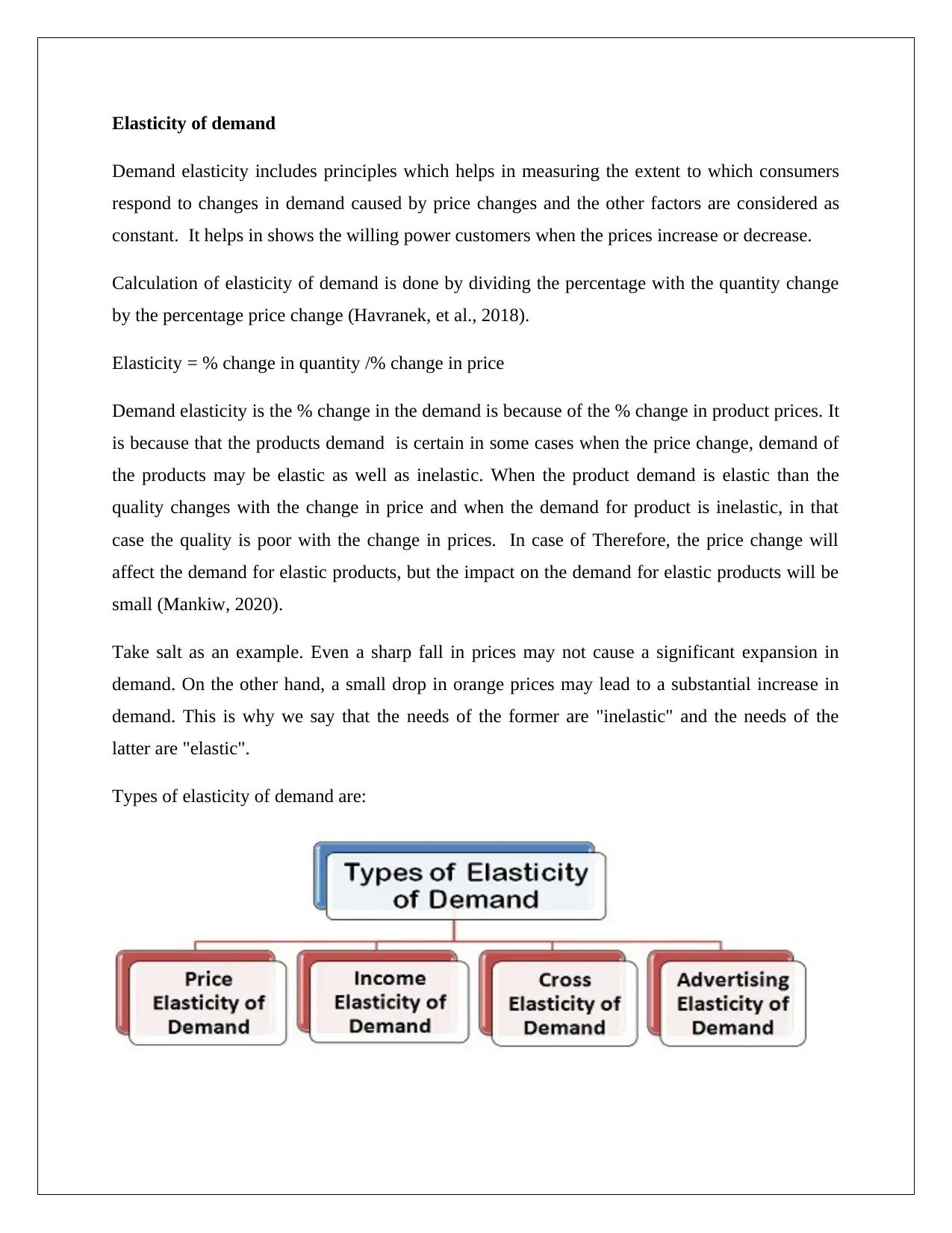
Elasticity of demand
Demand elasticity includes principles which helps in measuring the extent to which consumers
respond to changes in demand caused by price changes and the other factors are considered as
constant. It helps in shows the willing power customers when the prices increase or decrease.
Calculation of elasticity of demand is done by dividing the percentage with the quantity change
by the percentage price change (Havranek, et al., 2018).
Elasticity = % change in quantity /% change in price
Demand elasticity is the % change in the demand is because of the % change in product prices. It
is because that the products demand is certain in some cases when the price change, demand of
the products may be elastic as well as inelastic. When the product demand is elastic than the
quality changes with the change in price and when the demand for product is inelastic, in that
case the quality is poor with the change in prices. In case of Therefore, the price change will
affect the demand for elastic products, but the impact on the demand for elastic products will be
small (Mankiw, 2020).
Take salt as an example. Even a sharp fall in prices may not cause a significant expansion in
demand. On the other hand, a small drop in orange prices may lead to a substantial increase in
demand. This is why we say that the needs of the former are "inelastic" and the needs of the
latter are "elastic".
Types of elasticity of demand are:
Demand elasticity includes principles which helps in measuring the extent to which consumers
respond to changes in demand caused by price changes and the other factors are considered as
constant. It helps in shows the willing power customers when the prices increase or decrease.
Calculation of elasticity of demand is done by dividing the percentage with the quantity change
by the percentage price change (Havranek, et al., 2018).
Elasticity = % change in quantity /% change in price
Demand elasticity is the % change in the demand is because of the % change in product prices. It
is because that the products demand is certain in some cases when the price change, demand of
the products may be elastic as well as inelastic. When the product demand is elastic than the
quality changes with the change in price and when the demand for product is inelastic, in that
case the quality is poor with the change in prices. In case of Therefore, the price change will
affect the demand for elastic products, but the impact on the demand for elastic products will be
small (Mankiw, 2020).
Take salt as an example. Even a sharp fall in prices may not cause a significant expansion in
demand. On the other hand, a small drop in orange prices may lead to a substantial increase in
demand. This is why we say that the needs of the former are "inelastic" and the needs of the
latter are "elastic".
Types of elasticity of demand are:
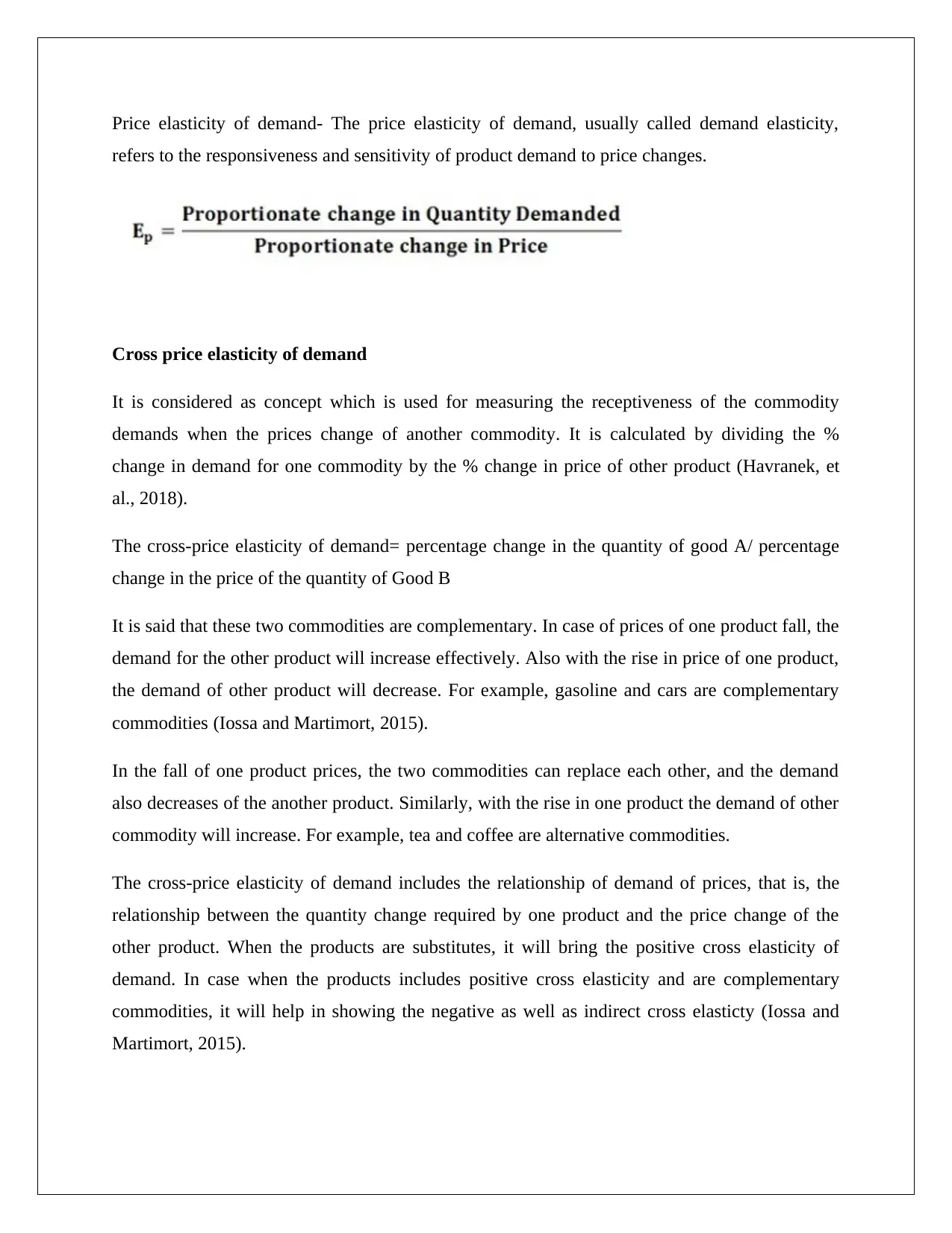
Price elasticity of demand- The price elasticity of demand, usually called demand elasticity,
refers to the responsiveness and sensitivity of product demand to price changes.
Cross price elasticity of demand
It is considered as concept which is used for measuring the receptiveness of the commodity
demands when the prices change of another commodity. It is calculated by dividing the %
change in demand for one commodity by the % change in price of other product (Havranek, et
al., 2018).
The cross-price elasticity of demand= percentage change in the quantity of good A/ percentage
change in the price of the quantity of Good B
It is said that these two commodities are complementary. In case of prices of one product fall, the
demand for the other product will increase effectively. Also with the rise in price of one product,
the demand of other product will decrease. For example, gasoline and cars are complementary
commodities (Iossa and Martimort, 2015).
In the fall of one product prices, the two commodities can replace each other, and the demand
also decreases of the another product. Similarly, with the rise in one product the demand of other
commodity will increase. For example, tea and coffee are alternative commodities.
The cross-price elasticity of demand includes the relationship of demand of prices, that is, the
relationship between the quantity change required by one product and the price change of the
other product. When the products are substitutes, it will bring the positive cross elasticity of
demand. In case when the products includes positive cross elasticity and are complementary
commodities, it will help in showing the negative as well as indirect cross elasticty (Iossa and
Martimort, 2015).
refers to the responsiveness and sensitivity of product demand to price changes.
Cross price elasticity of demand
It is considered as concept which is used for measuring the receptiveness of the commodity
demands when the prices change of another commodity. It is calculated by dividing the %
change in demand for one commodity by the % change in price of other product (Havranek, et
al., 2018).
The cross-price elasticity of demand= percentage change in the quantity of good A/ percentage
change in the price of the quantity of Good B
It is said that these two commodities are complementary. In case of prices of one product fall, the
demand for the other product will increase effectively. Also with the rise in price of one product,
the demand of other product will decrease. For example, gasoline and cars are complementary
commodities (Iossa and Martimort, 2015).
In the fall of one product prices, the two commodities can replace each other, and the demand
also decreases of the another product. Similarly, with the rise in one product the demand of other
commodity will increase. For example, tea and coffee are alternative commodities.
The cross-price elasticity of demand includes the relationship of demand of prices, that is, the
relationship between the quantity change required by one product and the price change of the
other product. When the products are substitutes, it will bring the positive cross elasticity of
demand. In case when the products includes positive cross elasticity and are complementary
commodities, it will help in showing the negative as well as indirect cross elasticty (Iossa and
Martimort, 2015).
⊘ This is a preview!⊘
Do you want full access?
Subscribe today to unlock all pages.

Trusted by 1+ million students worldwide
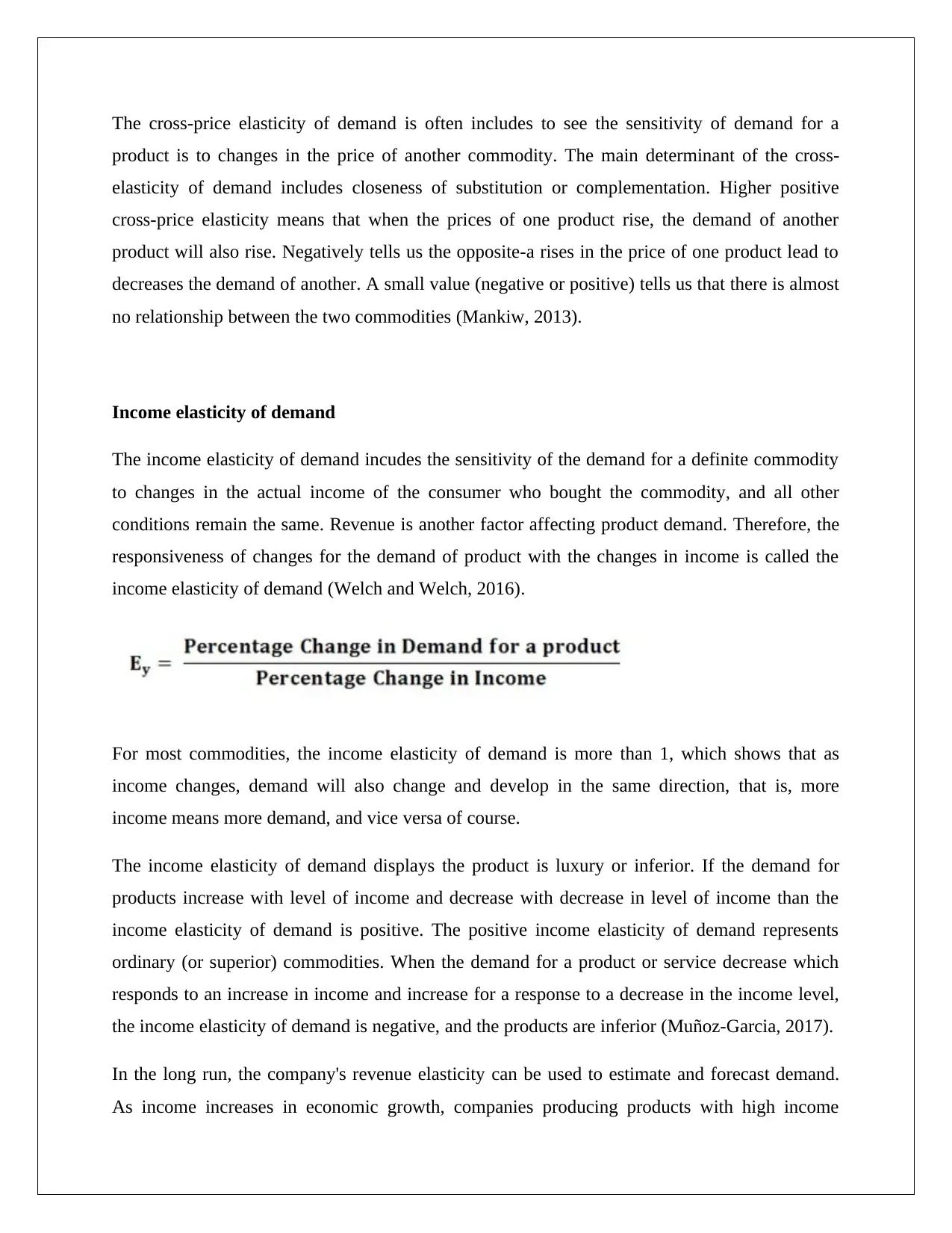
The cross-price elasticity of demand is often includes to see the sensitivity of demand for a
product is to changes in the price of another commodity. The main determinant of the cross-
elasticity of demand includes closeness of substitution or complementation. Higher positive
cross-price elasticity means that when the prices of one product rise, the demand of another
product will also rise. Negatively tells us the opposite-a rises in the price of one product lead to
decreases the demand of another. A small value (negative or positive) tells us that there is almost
no relationship between the two commodities (Mankiw, 2013).
Income elasticity of demand
The income elasticity of demand incudes the sensitivity of the demand for a definite commodity
to changes in the actual income of the consumer who bought the commodity, and all other
conditions remain the same. Revenue is another factor affecting product demand. Therefore, the
responsiveness of changes for the demand of product with the changes in income is called the
income elasticity of demand (Welch and Welch, 2016).
For most commodities, the income elasticity of demand is more than 1, which shows that as
income changes, demand will also change and develop in the same direction, that is, more
income means more demand, and vice versa of course.
The income elasticity of demand displays the product is luxury or inferior. If the demand for
products increase with level of income and decrease with decrease in level of income than the
income elasticity of demand is positive. The positive income elasticity of demand represents
ordinary (or superior) commodities. When the demand for a product or service decrease which
responds to an increase in income and increase for a response to a decrease in the income level,
the income elasticity of demand is negative, and the products are inferior (Muñoz-Garcia, 2017).
In the long run, the company's revenue elasticity can be used to estimate and forecast demand.
As income increases in economic growth, companies producing products with high income
product is to changes in the price of another commodity. The main determinant of the cross-
elasticity of demand includes closeness of substitution or complementation. Higher positive
cross-price elasticity means that when the prices of one product rise, the demand of another
product will also rise. Negatively tells us the opposite-a rises in the price of one product lead to
decreases the demand of another. A small value (negative or positive) tells us that there is almost
no relationship between the two commodities (Mankiw, 2013).
Income elasticity of demand
The income elasticity of demand incudes the sensitivity of the demand for a definite commodity
to changes in the actual income of the consumer who bought the commodity, and all other
conditions remain the same. Revenue is another factor affecting product demand. Therefore, the
responsiveness of changes for the demand of product with the changes in income is called the
income elasticity of demand (Welch and Welch, 2016).
For most commodities, the income elasticity of demand is more than 1, which shows that as
income changes, demand will also change and develop in the same direction, that is, more
income means more demand, and vice versa of course.
The income elasticity of demand displays the product is luxury or inferior. If the demand for
products increase with level of income and decrease with decrease in level of income than the
income elasticity of demand is positive. The positive income elasticity of demand represents
ordinary (or superior) commodities. When the demand for a product or service decrease which
responds to an increase in income and increase for a response to a decrease in the income level,
the income elasticity of demand is negative, and the products are inferior (Muñoz-Garcia, 2017).
In the long run, the company's revenue elasticity can be used to estimate and forecast demand.
As income increases in economic growth, companies producing products with high income
Paraphrase This Document
Need a fresh take? Get an instant paraphrase of this document with our AI Paraphraser
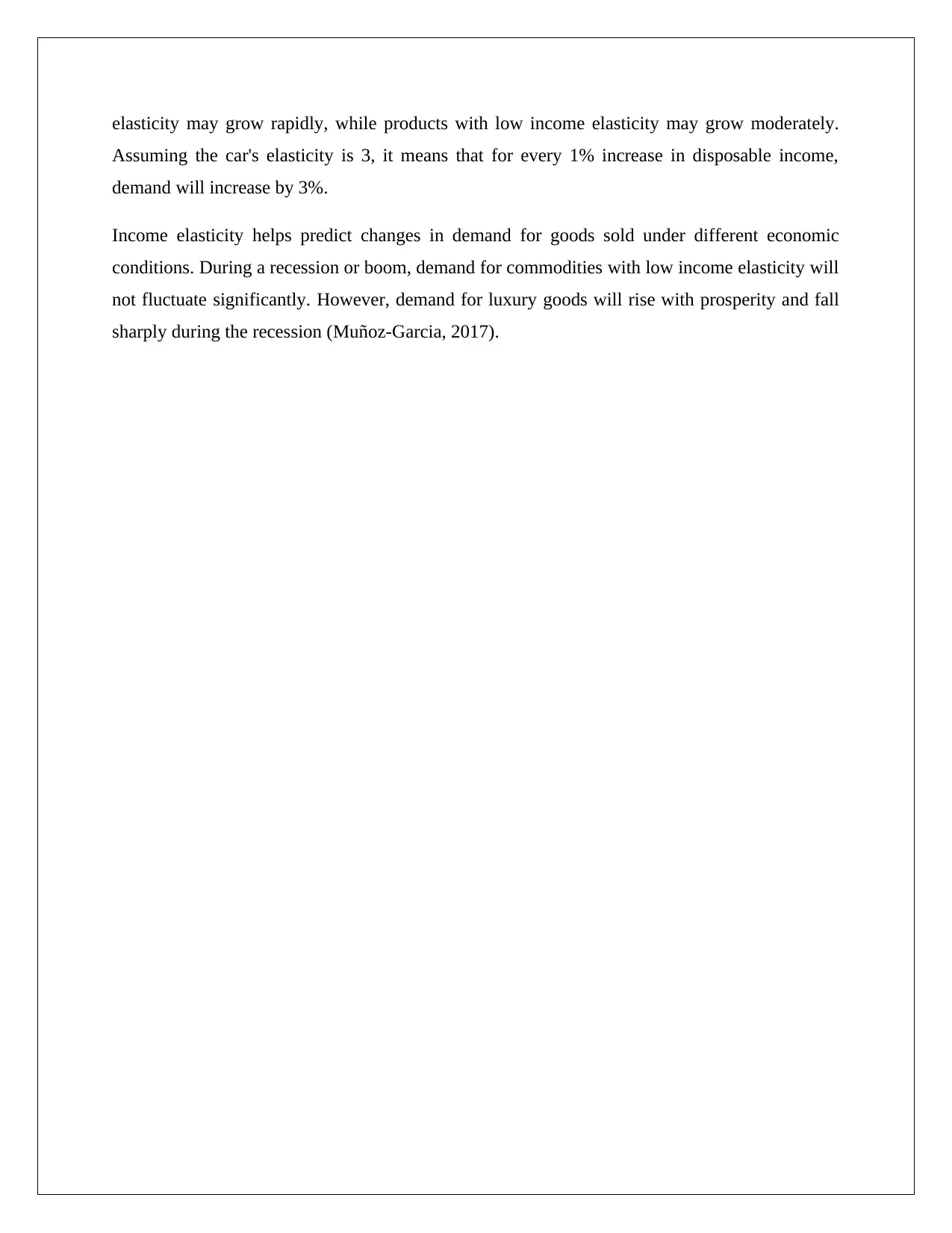
elasticity may grow rapidly, while products with low income elasticity may grow moderately.
Assuming the car's elasticity is 3, it means that for every 1% increase in disposable income,
demand will increase by 3%.
Income elasticity helps predict changes in demand for goods sold under different economic
conditions. During a recession or boom, demand for commodities with low income elasticity will
not fluctuate significantly. However, demand for luxury goods will rise with prosperity and fall
sharply during the recession (Muñoz-Garcia, 2017).
Assuming the car's elasticity is 3, it means that for every 1% increase in disposable income,
demand will increase by 3%.
Income elasticity helps predict changes in demand for goods sold under different economic
conditions. During a recession or boom, demand for commodities with low income elasticity will
not fluctuate significantly. However, demand for luxury goods will rise with prosperity and fall
sharply during the recession (Muñoz-Garcia, 2017).
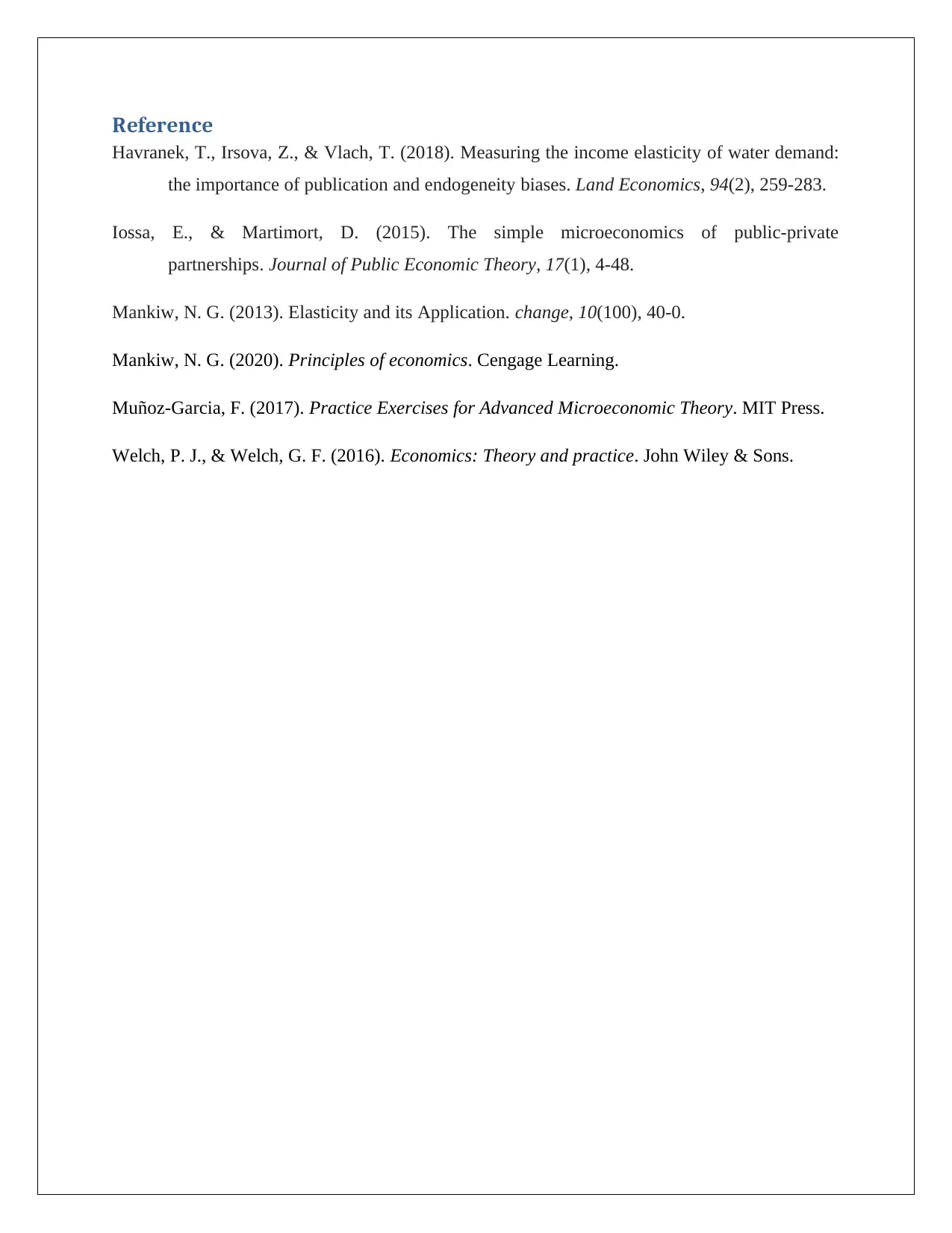
Reference
Havranek, T., Irsova, Z., & Vlach, T. (2018). Measuring the income elasticity of water demand:
the importance of publication and endogeneity biases. Land Economics, 94(2), 259-283.
Iossa, E., & Martimort, D. (2015). The simple microeconomics of public‐private
partnerships. Journal of Public Economic Theory, 17(1), 4-48.
Mankiw, N. G. (2013). Elasticity and its Application. change, 10(100), 40-0.
Mankiw, N. G. (2020). Principles of economics. Cengage Learning.
Muñoz-Garcia, F. (2017). Practice Exercises for Advanced Microeconomic Theory. MIT Press.
Welch, P. J., & Welch, G. F. (2016). Economics: Theory and practice. John Wiley & Sons.
Havranek, T., Irsova, Z., & Vlach, T. (2018). Measuring the income elasticity of water demand:
the importance of publication and endogeneity biases. Land Economics, 94(2), 259-283.
Iossa, E., & Martimort, D. (2015). The simple microeconomics of public‐private
partnerships. Journal of Public Economic Theory, 17(1), 4-48.
Mankiw, N. G. (2013). Elasticity and its Application. change, 10(100), 40-0.
Mankiw, N. G. (2020). Principles of economics. Cengage Learning.
Muñoz-Garcia, F. (2017). Practice Exercises for Advanced Microeconomic Theory. MIT Press.
Welch, P. J., & Welch, G. F. (2016). Economics: Theory and practice. John Wiley & Sons.
⊘ This is a preview!⊘
Do you want full access?
Subscribe today to unlock all pages.

Trusted by 1+ million students worldwide
1 out of 6
Related Documents
Your All-in-One AI-Powered Toolkit for Academic Success.
+13062052269
info@desklib.com
Available 24*7 on WhatsApp / Email
![[object Object]](/_next/static/media/star-bottom.7253800d.svg)
Unlock your academic potential
Copyright © 2020–2025 A2Z Services. All Rights Reserved. Developed and managed by ZUCOL.




